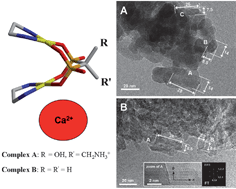Nanocrystalline carbonate-apatites: role of Ca/P ratio on the upload and release of anticancer platinum bisphosphonates†
Abstract
In the present study two nanocrystalline

* Corresponding authors
a
Dipartimento di Chimica “G. Ciamician”, Alma Mater Studiorum, Università di Bologna,
Via Selmi 2, Bologna, Italy
E-mail:
michele.iafisco@unibo.it
Fax: +390512099593
Tel: +390512099489
b Dipartimento di Scienze Mediche, Università del Piemonte Orientale, Via Solaroli 17, Novara, Italy
c Dipartimento di Chimica IFM & Centro Interdipartimentale di Eccellenza “Nanostructured Interfaces and Surfaces”—NIS Università degli Studi di Torino, Via P. Giuria 7, Torino, Italy
d Dipartimento Farmaco-Chimico, Università degli Studi di Bari “A. Moro”, Via Orabona 4, Bari, Italy
e Dipartimento di Scienze Farmaceutiche, Università di Padova, Via Marzolo 5, Padova, Italy
In the present study two nanocrystalline

 Please wait while we load your content...
Something went wrong. Try again?
Please wait while we load your content...
Something went wrong. Try again?
M. Iafisco, B. Palazzo, G. Martra, N. Margiotta, S. Piccinonna, G. Natile, V. Gandin, C. Marzano and N. Roveri, Nanoscale, 2012, 4, 206 DOI: 10.1039/C1NR11147G
To request permission to reproduce material from this article, please go to the Copyright Clearance Center request page.
If you are an author contributing to an RSC publication, you do not need to request permission provided correct acknowledgement is given.
If you are the author of this article, you do not need to request permission to reproduce figures and diagrams provided correct acknowledgement is given. If you want to reproduce the whole article in a third-party publication (excluding your thesis/dissertation for which permission is not required) please go to the Copyright Clearance Center request page.
Read more about how to correctly acknowledge RSC content.
 Fetching data from CrossRef.
Fetching data from CrossRef.
This may take some time to load.
Loading related content
